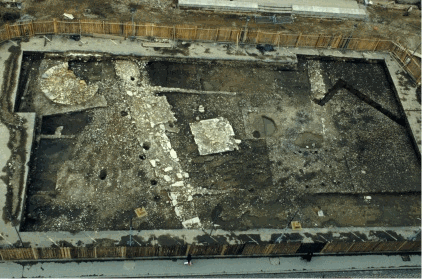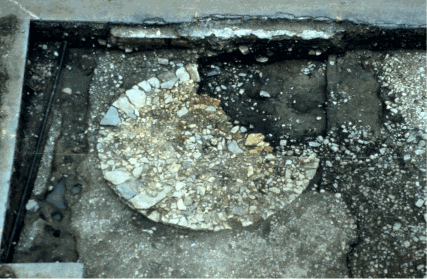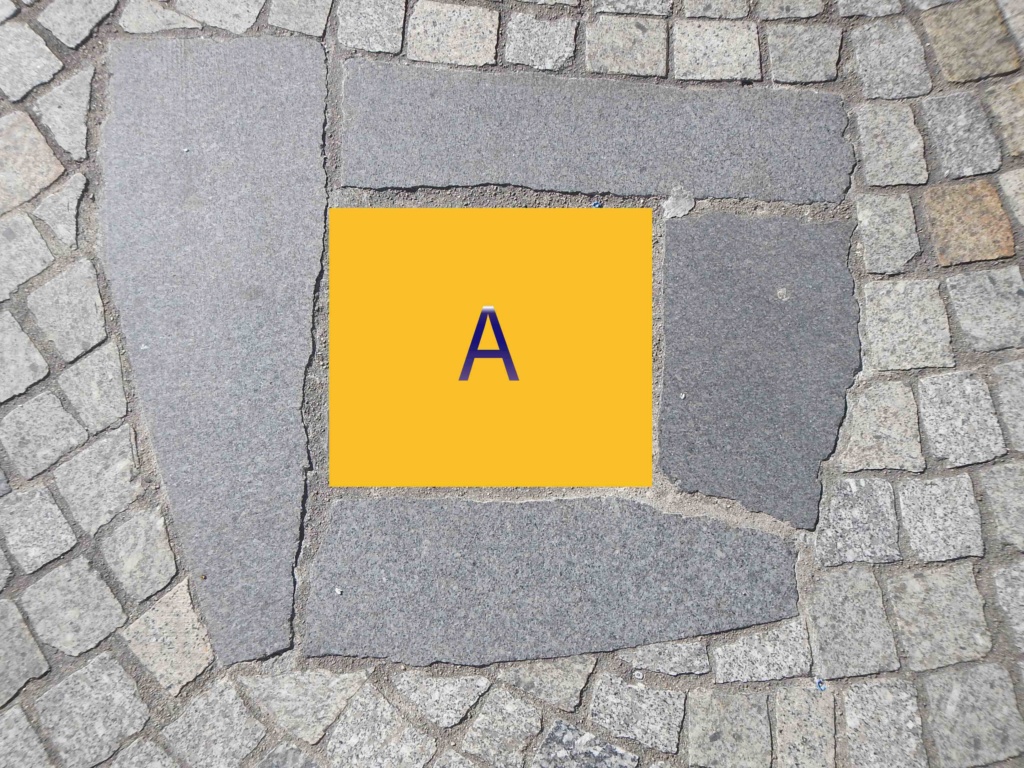Au cœur de Quimper, les fouilles de diagnostic, puis de sauvetage, conduites au pied de la cathédrale, place Laennec furent les plus importantes et les plus spectaculaires opérations archéologiques concernant l’histoire médiévale de la ville.
In the heart of Quimper, the diagnostic and rescue excavations at the foot of the cathedral, Laennec Square, were the most important and spectacular archaeological operations concerning the medieval history of the city.

Liées aux travaux de réaménagement de cet espace par la municipalité de Quimper, elles furent l’occasion de mettre au jour des vestiges sur plus de 1000 m² d’une zone qui, par grande chance, n’avaient presque pas été bouleversés depuis la fin du XVe siècle.
L’emplacement du pilori, élevé au début du XVe siècle, est toujours visible aujourd’hui.
Il s’agit de notre zone de référence.
Related to the redevelopment of this space by the municipality of Quimper, they were an opportunity to uncover vestiges over more than 1000 m² of an area that, by much luck, had hardly been disrupted since the end. 15th century.
The location of the pillory, raised in the early fifteenth century, is still visible today.
This is our reference area.

Une roche métamorphique est un type de roches dont la formation a pour origine la transformation à l'état solide des roches sédimentaires, magmatiques ou encore métamorphiques, en raison des modifications des paramètres physico-chimiques du milieu dans lequel elles évoluent (notamment la pression et la température). Cette transformation, désignée sous le terme de métamorphisme, se traduit par une modification de la texture, de l'assemblage minéralogique à l'équilibre ou de la composition chimique de la roche. La roche originelle d'une roche métamorphique est appelée le protolithe.
Les types de roches métamorphiques sont déterminés à partir d'éléments observés, tels que les structures ou les minéraux, sur ces dernières. Les grands groupes de roches métamorphiques se répartissent entre
les schistes,
Un schiste est une roche qui a pour particularité d'avoir un aspect feuilleté, et de se débiter en plaques fines ou « feuillet rocheux ». On dit qu'elle présente une schistosité. Il peut s'agir d'une roche sédimentaire argileuse, ou bien d'une roche métamorphique. Quand celle-ci est purement sédimentaire, les géologues préfèrent utiliser le terme « shale ».
Cette dernière distinction est importante pour les ingénieurs pétroliers et gaziers, car une roche métamorphique ne peut pas contenir une quantité significative d'hydrocarbures puisque la température lors de la formation de ces roches dégrade ce type de molécules. Il serait donc plus précis de parler de gaz de shale bien que le terme gaz de schiste ait été popularisé.
Pour ajouter à la confusion, on emploie souvent le terme d'ardoise pour désigner le schiste - l'ardoise étant un type de schiste métamorphique, à grain fin.
les gneiss,
Le gneiss ([gnɛs]) est une roche métamorphique de la croûte continentale contenant du quartz, du mica, des feldspaths plagioclases et parfois du feldspath alcalin, tous suffisamment gros pour être identifiés à l'œil nu. La foliation, toujours présente, est parfois marquée par l'alternance de petits lits clairs et de fins niveaux plus sombres (on parle alors de litage métamorphique).
les marbres,
le marbre est une roche métamorphique dérivée du calcaire et constituée principalement de cristaux de calcite. En architecture, sculpture et marbrerie ce terme peut désigner n'importe quelle pierre difficile à tailler et capable de prendre un beau poli, dont les plus courantes sont les « vrais » marbres (au sens géologique).
Les marbres de la géologie présentent une grande diversité de coloris, bien que la couleur de base de la calcite soit le blanc. On y trouve fréquemment des veines appelées marbrures. Les veines et les coloris sont généralement dus à des inclusions d'oxydes métalliques. Certains types de marbre portent des noms particuliers, par exemple le cipolin ou la griotte. Certains marbres, comme le vert antique, composés de calcaire et de serpentine, sont des ophicalces.
et métabasites.
Une granulite est une roche métamorphique catazonale de haute pression et haute température. Le terme granulite vient du latin granulum, petit grain et du grec lithos, pierre. De structure granuloblastique, elle est composée de quartz et de feldspath (orthose, plagioclase) avec, selon les cas, de l'hypersthène et du grenat. Dans le métamorphisme général, on parle de faciès à granulite.
Un exemple :
L’ardoise est une roche métamorphique qui s'est formée dans de fortes conditions de pression et de température. Elle appartient à la famille des schistes à l'intérieur de laquelle elle se distingue par la qualité de son grain, très fin, et sa fissilité. Ces propriétés font qu'on peut l'utiliser comme matériau de couverture.
L'ardoise est résistante et sa couleur peut varier du blanc au noir, en passant par toutes sortes de gris, de rouges sombres et de verts.
Dans le domaine de la construction, l'ardoise ne se contente plus de couvrir les toits mais sert aussi en parement protecteur et en dallage.
A metamorphic rock is a type of rock whose formation originates from the solid state transformation of sedimentary, magmatic or metamorphic rocks, due to changes in the physico-chemical parameters of the environment in which they evolve (in particular the pressure and temperature). This transformation, referred to as metamorphism, results in a modification of the texture, the equilibrium mineral assemblage or the chemical composition of the rock. The original rock of a metamorphic rock is called the protolith.
The types of metamorphic rocks are determined from observed elements, such as structures or minerals, on the latter. Large groups of metamorphic rocks are distributed between
shales,
A shale is a rock that has the particularity of having a laminated appearance, and to be sold in thin plates or "rocky sheet". It is said to have schistosity. It may be a clayey sedimentary rock, or a metamorphic rock. When it is purely sedimentary, geologists prefer to use the term "shale" 1.
This last distinction is important for oil and gas engineers, because a metamorphic rock can not contain a significant amount of hydrocarbons since the temperature during the formation of these rocks degrades this type of molecules. It would be more accurate to speak of shale gas although the term shale gas has been popularized.
To add to the confusion, the term slate is often used to refer to shale - slate being a type of fine-grained, metamorphic shale.
the gneisses,
Gneiss ([gnɛs]) is a metamorphic rock of the continental crust containing quartz, mica, plagioclase feldspars and sometimes alkaline feldspar, all large enough to be identified with the naked eye. The foliation, always present, is sometimes marked by the alternation of small light beds and darker levels (we speak of metamorphic bedding).
the marbles,
marble is a metamorphic rock derived from limestone and consisting mainly of calcite crystals. In architecture, sculpture and marble work this term can refer to any stone that is difficult to cut and able to take a beautiful polish, the most common of which are the "real" marbles (in the geological sense).
The marbles of geology show a great diversity of colors, although the basic color of calcite is white. There are frequently veins called marbling. Veins and colors are usually due to inclusions of metal oxides. Some types of marble have special names, such as cipolin or sour cherry. Some marbles, like the ancient green, composed of limestone and serpentine, are ophicalces.
and metabasites.
Granulite is a catazonal metamorphic rock of high pressure and high temperature. The term granulite comes from the Latin granulum, petit grain and Greek lithos, stone.
Of granuloblastic structure, it is composed of quartz and feldspar (orthoclase, plagioclase) with, depending on the case, hypersthene and garnet1.
In general metamorphism, we speak of granulite facies.
An example :
Slate is a metamorphic rock that has formed in strong pressure and temperature conditions. It belongs to the family of schists inside which it is distinguished by the quality of its grain, very fine, and its fissility. These properties make it suitable for use as a roofing material.
Slate is resistant and its color can vary from white to black, passing through all kinds of gray, dark reds and greens.
In the field of construction, slate is no longer content to cover the roofs but also serves as protective siding and paving.
Rendez-vous au point de référence.
Questions après un examen visuel et tactile :
Décrivez les caractéristiques de la roche A (couleur, taille du grain, dureté...).
Go to the reference point.
Questions after a visual and tactile examination:
Describe the characteristics of rock A (color, grain size, hardness ...).

Déduisez-en la nature de cette roche et à quelle famille elle appartient.
Deduce the nature of this rock and to which family it belongs.

"Loguez cette cache "Found it" et envoyez-moi vos propositions de réponses soit via mon profil, soit via la messagerie geocaching.com (Message Center), et je vous contacterai en cas de problème."
Les photos sur site de votre GPS sont les bienvenues mais facultatives.
En complément et pour aller plus loin avec mes remerciements :
"Log this cache" Found it "and send me your suggested answers either through my profile or via the messaging geocaching.com (Message Center), and I will contact you in case of problems."
On-site photos of your GPS are welcome but optional.
In addition and to go further with my thanks:
Wikipédia : https://fr.wikipedia.org/wiki/Roche_m%C3%A9tamorphique
http://www.sahpl.asso.fr/SITE_SAHPL/Le_Bihan_Quimper_Vestiges_place_Laennec.htm